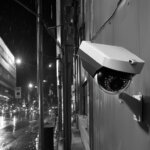Table of Contents
If you’re curious about what CCTV is and how it works, you’ve come to the right place. In this section, we will walk you through the basics of CCTV, its importance, and its various functions in security systems. Whether you’re a business owner, school administrator, or simply interested in enhancing your security measures, understanding CCTV is essential.
So, what is CCTV? Closed-circuit television (CCTV) security systems are becoming increasingly popular in commercial businesses, schools, and small businesses. They serve as a powerful tool in combating property crimes, thefts, and internal fraud. A basic CCTV security system consists of cameras, recording systems, monitors, video management software (VMS), and other accompanying equipment.
There are two main types of CCTV cameras: Internet Protocol (IP) cameras and analog cameras. IP cameras are preferred due to their compatibility with most applications, while analog cameras are more suitable for legacy digital recording systems with older technology. Additionally, both wired and wireless CCTV cameras are available, with wired cameras being ideal for larger properties and wireless cameras being suitable for smaller spaces.
Recording systems such as network video recorders (NVRs) and digital video recorders (DVRs) play a crucial role in storing and managing the recorded footage. Monitors and video management software (VMS) provide high-definition displays and control over the CCTV system.
Proper installation and setup, along with considerations for cables, power supplies, and routers, are necessary for seamless integration and optimal performance of CCTV systems. CCTV technology finds its applications in deterring criminal activities, monitoring employee productivity, protecting against intrusions, managing restaurant/bar activities, and assisting law enforcement in investigations and traffic studies.
Stay tuned as we dive deeper into the functioning, components, and benefits of CCTV cameras in the upcoming sections.
How Does CCTV Work?
Closed-circuit television (CCTV) systems operate by strategically positioning cameras to capture video footage, which is then transmitted to monitors or video recorders via private coaxial cable runs or wireless communication links.
- The Camera: The main component of a CCTV system is the camera. Equipped with an image sensor, the camera converts light into electrical signals to capture video footage.
- Cables and Connectors: These components facilitate the transmission of video signals from the camera to the digital video recorder (DVR). They ensure a seamless transfer of data.
- Digital Video Recorder (DVR): The DVR receives and processes the video signals from the camera. It converts analog signals into a digital format for storage, playback, and managing recording and monitoring settings.
- Monitor: The monitor displays the live or recorded video feed from the CCTV cameras. Operators can view the surveillance footage in real time, allowing for immediate response.
The image capture process starts with collecting light through the camera lens. The camera’s image sensor converts the light into electrical signals, which are then processed to refine the video image. The processed video signals are transmitted to the DVR for storage and monitoring.
Proper installation and setup are essential for CCTV systems. Factors such as camera placement, mounting options, and connecting cameras to the DVR should be considered for optimal functioning. CCTV cameras provide the ability to monitor and record live video footage, with the DVR storing the recorded data for later playback.
Enhancing overall security infrastructure, CCTV cameras can be integrated with other security systems, such as alarms or access control. This integration offers a comprehensive solution, promoting deterrence and prevention against crimes, enabling surveillance and monitoring, facilitating real-time response to security incidents, aiding in investigations and evidence gathering, and promoting employee and public safety.
Benefits of CCTV Cameras
“CCTV cameras play a vital role in enhancing security by providing visual surveillance and monitoring, acting as a deterrent, and aiding in investigations.” – Security Expert
| Benefits | Description |
|---|---|
| Deterrence and Prevention | CCTV cameras deter potential criminals and discourage unauthorized activities, serving as a preventive measure against crimes. |
| Surveillance and Monitoring | CCTV cameras enable continuous monitoring, allowing operators to identify suspicious activities or behaviors in real time, thereby preventing security incidents. |
| Real-time Response | Live monitoring facilitates immediate response to security incidents or emergencies, enabling prompt action to address threats or risks. |
| Investigation and Evidence Gathering | Recorded CCTV footage serves as valuable evidence in investigations, assisting law enforcement in identifying suspects and gathering information. |
| Integration with Other Security Systems | CCTV cameras can be integrated with other security systems, such as alarms or access control, enhancing the overall security infrastructure. |
| Employee and Public Safety | By promoting a safer environment for employees, customers, and the general public, CCTV cameras instill a sense of security. |
When selecting CCTV cameras, factors to consider include purpose and location, image quality and resolution, weatherproofing and durability, wired or wireless options, integration capabilities, and budget. Choosing the right CCTV cameras ensures clear and detailed video footage, reliable performance, and seamless integration with existing security systems if needed.
Understanding CCTV Cameras
CCTV cameras, also known as closed-circuit television cameras, are surveillance technology used to monitor and record activities in specific areas. They consist of various components that work together to ensure effective surveillance and reliable recording.
Components of CCTV Cameras
The components of CCTV cameras include:
- The camera itself: This is the main device responsible for capturing video footage. It converts light into electrical signals through its image sensor, allowing for the creation of a visual record.
- Cables and connectors: These facilitate the transmission of video signals from the camera to the digital video recorder (DVR). They ensure a seamless connection and reliable transfer of data.
- Digital Video Recorder (DVR): The DVR receives and processes the video signals from the camera. It converts the analog signals into a digital format for storage and playback. The DVR also manages recording settings and provides control over the surveillance system.
- Monitor: The monitor displays the live or recorded video feed from the CCTV cameras. It allows operators to view the surveillance footage in real time and facilitates monitoring of the premises.
Image Capture Process
The image capture process of CCTV cameras involves several steps:
- Light collection: The camera lens captures light from the surroundings.
- Conversion of light into electrical signals: The camera’s image sensor converts the captured light into electrical signals.
- Signal processing: The electrical signals are processed to refine the video image, enhancing its quality and clarity.
- Transmission of processed signals: The processed video signals are transmitted from the camera to the DVR using the cables and connectors.
The DVR stores the recorded data, enabling playback and review of the captured footage.
Installation and Setup
Proper installation and setup of CCTV cameras are vital for their optimal functioning. Considerations include:
- Camera placement: Determining the optimal positions for camera installation to ensure maximum coverage of the area of interest.
- Mounting options: Choosing the appropriate mounting options to securely position the cameras.
- Connection to the DVR: Ensuring proper connectivity between the cameras and the DVR through cables and connectors.
Benefits of CCTV Cameras
CCTV cameras offer a range of benefits, including:
“CCTV cameras provide deterrence and prevention against criminal activities, facilitate surveillance and monitoring, enable real-time response to security incidents, aid in investigations and evidence gathering, integrate with other security systems, and promote employee and public safety.”
Choosing CCTV Cameras
When selecting CCTV cameras, factors to consider include:
- Purpose and location of installation
- Image quality and resolution
- Weatherproofing and durability for outdoor use
- Wired or wireless options
- Integration capabilities with other security systems
- Budget constraints
Choosing the right CCTV cameras ensures clear and detailed video footage, reliable performance, and seamless integration with existing security systems, if necessary.
Enhancing Security with CCTV Cameras
CCTV cameras play a crucial role in enhancing security and protection by providing visual surveillance and monitoring. They act as a deterrent to potential threats, aid in real-time surveillance, provide essential evidence for investigations, and promote overall safety in various settings.
CCTV cameras are effective in deterring potential criminals and discouraging unauthorized activities, acting as a preventive measure against crimes. With continuous monitoring, operators can identify suspicious activities or behaviors in real time, thereby preventing security incidents.
Live monitoring enables immediate response to security incidents or emergencies, allowing for prompt action to address threats or risks. Additionally, recorded CCTV footage serves as valuable evidence in investigations, assisting law enforcement in identifying suspects and gathering crucial information.
CCTV cameras can be integrated with other security systems, such as alarms or access control, to enhance the overall security infrastructure, providing a comprehensive solution. By promoting a safer environment for employees, customers, and the general public, CCTV cameras instill a sense of security and peace of mind.
When selecting CCTV cameras, it is important to consider factors such as the purpose and location of installation, image quality and resolution, weatherproofing and durability, wired or wireless options, integration capabilities, and budget. Choosing the right CCTV cameras ensures clear and detailed video footage, reliable performance, and seamless integration with existing security systems if needed.
FAQ
What is CCTV?
CCTV stands for closed-circuit television. It is a security system that uses cameras to monitor and record activities in specific areas.
What are the basic components of a CCTV system?
A basic CCTV system includes cameras, recording systems, monitors, video management software (VMS), and other accompanying equipment.
What are the two main types of CCTV cameras?
The two main types of CCTV cameras are Internet Protocol (IP) cameras and analog cameras.
What are the differences between IP cameras and analog cameras?
IP cameras are preferred due to their compatibility with most applications, while analog cameras are suitable for legacy digital recording systems with older technology.
Are there wired and wireless CCTV cameras available?
Yes, both wired and wireless CCTV cameras are available. Wired cameras are ideal for larger properties, while wireless cameras are suitable for smaller spaces.
What are the main recording systems used in CCTV?
Network video recorders (NVRs) are a better fit for IP camera integrations, while digital video recorders (DVRs) are more prevalent.
What are the essential components of a CCTV system?
The essential components of a CCTV system are cameras, cables and connectors, a digital video recorder (DVR), and a monitor.
How does the image capture process work in CCTV?
The image capture process involves collecting light through the camera lens, converting the light into electrical signals, processing the signals to refine the video image, and transmitting the processed video signals to the DVR.
What factors should be considered for proper installation and setup of CCTV cameras?
Proper installation and setup of CCTV cameras require considerations for camera placement, mounting options, and connecting the cameras to the DVR.
What are the applications of CCTV technology?
CCTV technology has various applications, including deterring criminal activities, monitoring employee productivity, protecting against intrusions, reviewing shipping/receiving protocols, deterring theft and fraud, managing restaurant/bar activities, surveillance of employee activity and productivity, monitoring crowd control and occupancy, and assisting law enforcement during criminal investigations and traffic studies.
How can CCTV cameras enhance security?
CCTV cameras enhance security by providing deterrence and prevention against crimes, enabling surveillance and monitoring, allowing for real-time response to security incidents, aiding in investigations and evidence gathering, and promoting employee and public safety.
What factors should be considered when choosing CCTV cameras?
Factors to consider when choosing CCTV cameras include the purpose and location of installation, image quality and resolution, weatherproofing and durability, wired or wireless options, integration capabilities, and budget.












